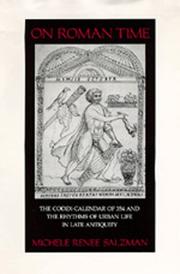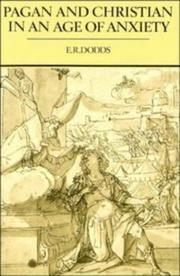| Listing 1 - 4 of 4 |
Sort by
|

ISBN: 1282355457 0520909100 9786612355455 0585139881 9780520909106 9780585139883 0520065662 9780520065666 Year: 1990 Volume: 17 Publisher: Berkeley: University of California press,
Abstract | Keywords | Export | Availability | Bookmark
 Loading...
Loading...Choose an application
- Reference Manager
- EndNote
- RefWorks (Direct export to RefWorks)
Because they list all the public holidays and pagan festivals of the age, calendars provide unique insights into the culture and everyday life of ancient Rome. The Codex-Calendar of 354 miraculously survived the Fall of Rome. Although it was subsequently lost, the copies made in the Renaissance remain invaluable documents of Roman society and religion in the years between Constantine's conversion and the fall of the Western Empire. In this richly illustrated book, Michele Renee Salzman establishes that the traditions of Roman art and literature were still very much alive in the mid-fourth century. Going beyond this analysis of precedents and genre, Salzman also studies the Calendar of 354 as a reflection of the world that produced and used it. Her work reveals the continuing importance of pagan festivals and cults in the Christian era and highlights the rise of a respectable aristocratic Christianity that combined pagan and Christian practices. Salzman stresses the key role of the Christian emperors and imperial institutions in supporting pagan rituals. Such policies of accommodation and assimilation resulted in a gradual and relatively peaceful transformation of Rome from a pagan to a Christian capital.
Calendar, Roman. --- Rome - Religious life and customs. --- Related Historical Sciences --- History & Archaeology --- Calendars & Chronologies --- Rome --- Social life and customs. --- Religious life and customs. --- Calendar [Roman ] --- Calendrier romain --- Kalender [Romeinse ] --- Calendar, Roman --- -Roman calendar --- Social life and customs --- Religious life and customs --- Vie religieuse --- Moeurs et coutumes --- Rome - Social life and customs. --- HISTORY / Ancient / General. --- Rome - Social life and customs --- Rome - Religious life and customs --- 354. --- ammianus marcellinus. --- ancient rome. --- ancient world. --- antiquity. --- assimilation. --- catholic church. --- christian capital. --- christian emperors. --- christian rome. --- christianity. --- church history. --- codex calendar. --- constantine. --- conversion. --- early church. --- fall of rome. --- festivals. --- history. --- holidays. --- nonfiction. --- pagan cults. --- pagan rome. --- pagan. --- paganism. --- pre julian calendar. --- religion. --- religious freedom. --- religious studies. --- roman art. --- roman calendar. --- roman empire. --- roman literature. --- roman society. --- urban rome. --- western empire. --- Roman calendar --- Rites et cérémonies --- Rites et cérémonies
Book
ISBN: 8810407881 9788810407882 Year: 1990 Publisher: Bologna: Dehoniane,
Abstract | Keywords | Export | Availability | Bookmark
 Loading...
Loading...Choose an application
- Reference Manager
- EndNote
- RefWorks (Direct export to RefWorks)
Christianity and other religions --- Paganism --- Toleration --- Christianisme --- Paganisme --- Tolérance --- Greek --- Roman --- Relations --- Religion grecque --- Religion romaine --- Rome --- Religion --- 261.2 --- -Christianity and other religions --- -Paganism --- Bigotry --- Intolerance --- Tolerance --- Virtues --- Discrimination --- Civilization, Pagan --- Heathenism --- Religions --- Christianity --- Syncretism (Christianity) --- De Kerk en het klassieke heidendom --- History --- Paganism. --- Toleration. --- Greek. --- Roman. --- 261.2 De Kerk en het klassieke heidendom --- Tolérance --- Christianity and other religions - Roman --- Christianity and other religions - Greek

ISBN: 0521385997 0521048494 0511096585 0511583583 9780521385992 Year: 1990 Volume: 1963 Publisher: Cambridge: Cambridge university press,
Abstract | Keywords | Export | Availability | Bookmark
 Loading...
Loading...Choose an application
- Reference Manager
- EndNote
- RefWorks (Direct export to RefWorks)
Interest in the world of Late Antiquity is currently undergoing a significant revival, and in this provocative book, now reissued in paperback, E. R. Dodds anticipated some of the themes now engaging scholars. There is abundant material for the study of religious experience in late antiquity, and through it Professor Dodds examines, from a sociological and psychological standpoint, the personal religious attitudes and experiences common to pagans and Christians in the period between Marcus Aurelius and Constantine. He looks first at general attitudes to the world and the human condition before turning to specific types of human experience. World-hatred and asceticism, dreams and states of possession, and pagan and Christian mysticism are all discussed. Finally Dodds considers both pagan views of Christianity and Christian views of paganism as they emerge in the literature of the time. Although primarily written for social and religious historians, this study will also appeal to all those interested in the ancient world and its thought.
Experience (Religion) --- -Christianity --- -Paganism --- -#GOSA:II.P.Alg.M --- Civilization, Pagan --- Heathenism --- Religions --- Christianity --- Church history --- Religious experience --- Psychology, Religious --- History --- Early church, ca. 30-600 --- Paganism --- #GOSA:II.P.Alg.M --- Apostolic Church --- Church, Apostolic --- Early Christianity --- Early church --- Primitive and early church --- Primitive Christianity --- Fathers of the church --- Great Apostasy (Mormon doctrine) --- History. --- Arts and Humanities --- Religion --- Experience (Religion) - History. --- Church history - Primitive and early church, ca. 30-600. --- Paganism - History.
Book
ISBN: 0521392764 9780521392761 Year: 1990 Publisher: Cambridge : Cambridge university press,
Abstract | Keywords | Export | Availability | Bookmark
 Loading...
Loading...Choose an application
- Reference Manager
- EndNote
- RefWorks (Direct export to RefWorks)
Hellenism --- Hellenisme --- Hellénisme --- Church history --- Paganism --- Eglise --- Paganisme --- History --- Histoire --- Hellenism. --- History. --- -Church history --- -Christianity --- Ecclesiastical history --- History, Church --- History, Ecclesiastical --- Christianity --- Civilization, Pagan --- Heathenism --- Religions --- -History --- Civilisation grecque antique --- Hellénisme antique --- Hellénisme --- Apostolic Church --- Church, Apostolic --- Early Christianity --- Early church --- Primitive and early church --- Primitive Christianity --- Fathers of the church --- Great Apostasy (Mormon doctrine) --- Primitive and early church, ca. 30-600 A.D. --- Mediterranean region --- Christianity - Early church, ca. 30-600. --- Paganism - Mediterranean Region - History. --- Church history - Primitive and early church, ca. 30-600. --- Christianisme --- 30-600 (Église primitive) --- Méditerranée (région)
| Listing 1 - 4 of 4 |
Sort by
|

 Search
Search Feedback
Feedback About UniCat
About UniCat  Help
Help News
News